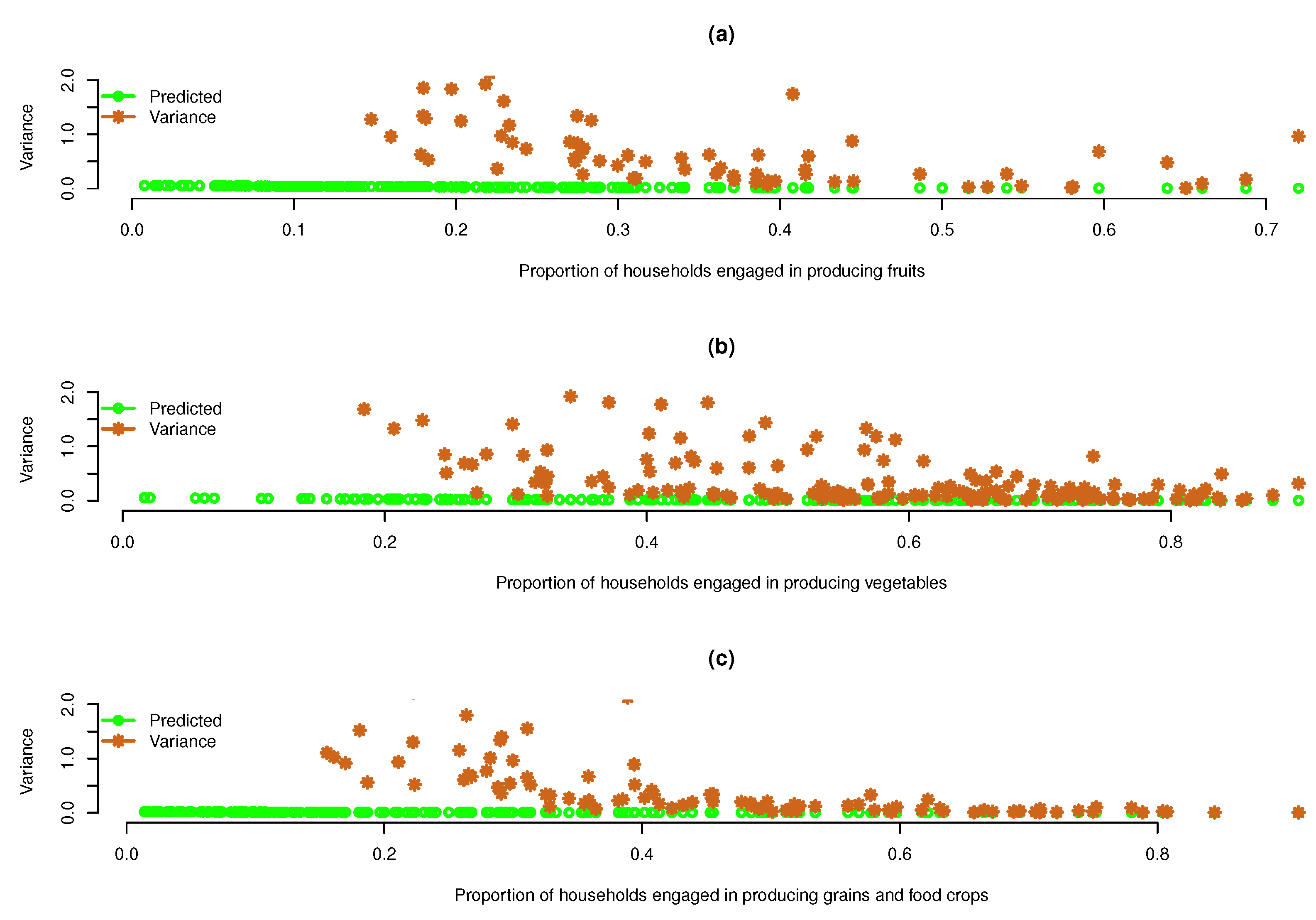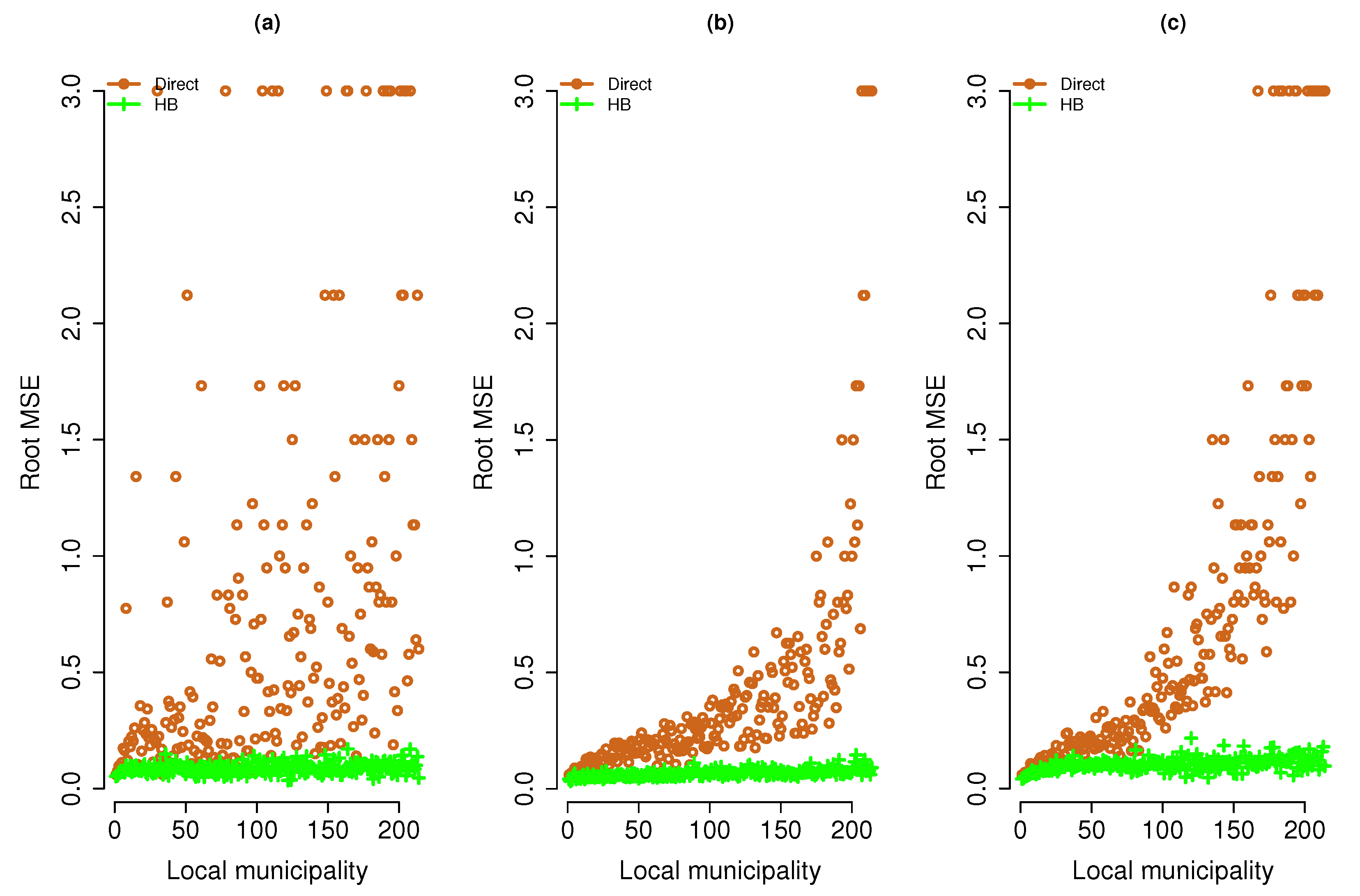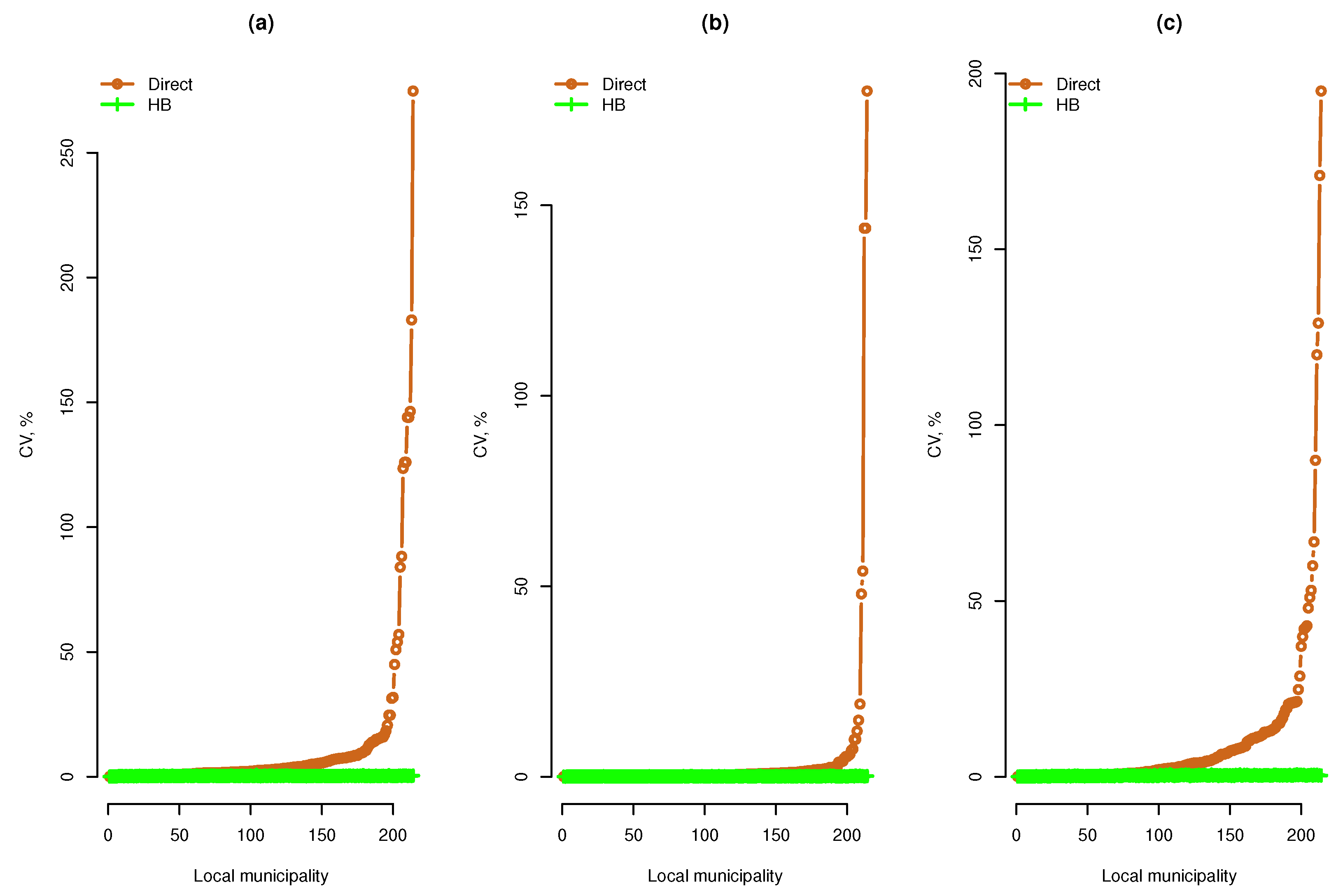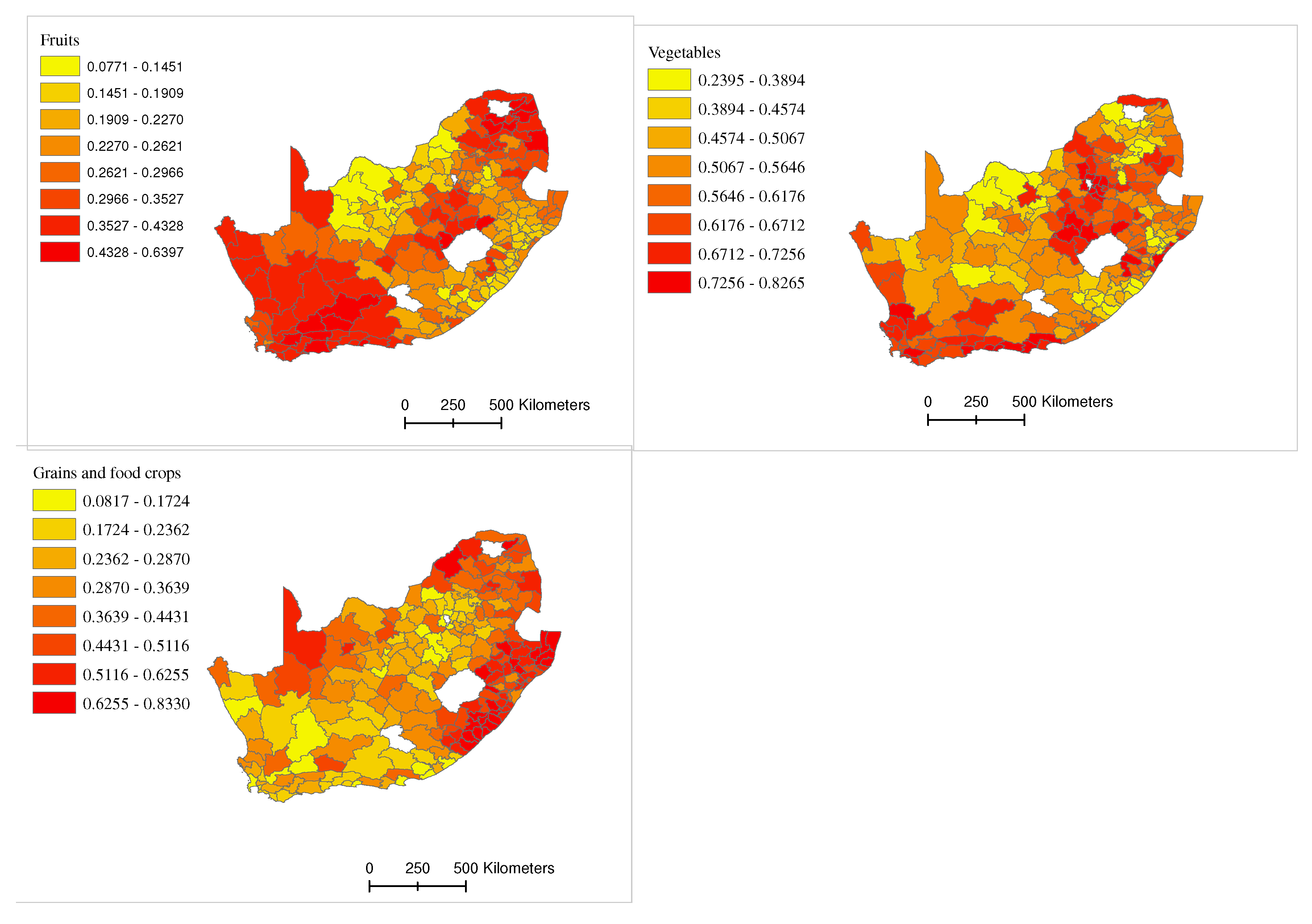Mapping Disaggregate-Level Agricultural Households in South Africa Using a Hierarchical Bayes Small Area Estimation Approach
Abstract
1. Introduction
“If we don’t get sustainability right in agriculture first, it won’t happen anywhere.”— Wes Jackson
2. Materials and Methods
2.1. Data
2.2. Small Area Estimation Methodology
2.2.1. The Fay-Herriot (FH) Model
2.2.2. The Hierarchical Bayes (HB) Approach
- Model 1 (M1): The FH model (Equations (1) and (2)) with known sampling variance
- Sampling model:
- Linking model:
- Model 2 (M2): The two-stage mixed log-normal model, which incorporates both the sampling and linking models, is given as follows:
- Sampling model:
- Unmatched linking model:
- Model 3 (M3): The two-stage mixed logistic model with known sampling variance, which includes both the linking model and the sampling model, is given as follows:
- Sampling model:
- Unmatched linking model:
- Both M2 and M3 are unmatched area-level models
- [18].
Prior Specification for the Parameters in the Model
- (i)
- Specify prior distributions for the model parameters and . The Bayesian inference drawn from posterior distribution is highly dependent on a wide range of prior distributions. Therefore, prior specification for the parameters in the model plays a vital role in Bayesian inference [30]. Following [30], we considered uniform prior for the prior variance , that is Uniform . Furthermore, for prior, we considered a normal distribution, that is .
- (ii)
- Generate data from the posterior distributions of , and from MCMC simulations. The HB estimates of the true proportions obtained from each of the priors were approximated by 50,000 independent samples of the MCMC method.
2.2.3. Generalized Variance Function
3. Results
4. Discussion
5. Conclusions
Funding
Institutional Review Board Statement
Data Availability Statement
Acknowledgments
Conflicts of Interest
References
- FAO. The Role of Agriculture and Rural Development in Achieving SDG 1.1; FAO: Rome, Italy, 2019. [Google Scholar]
- FAO. SDG Indicator 2.4.1 –Proportion of Agricultural Area under Productive and Sustainable Agriculture; FAO: Rome, Italy, 2020. [Google Scholar]
- ILO. Safety and Health in Agriculture; ILO: Geneva, Switzerland, 2000. [Google Scholar]
- Herforth, A.; Jones, A.; Pinstrup-Andersen, P. Prioritizing Nutrition in Agriculture and Rural Development: Guiding Principles for Operational Investments. Health, Nutrition, and Population (HNP) Discussion Paper; World Bank: Washington, DC, USA, 2012. [Google Scholar]
- Nyantakyi-Frimpong, H. Agricultural diversification and dietary diversity: A feminist political ecology of the everyday experiences of landless and smallholder households in northern Ghana. Geoforum 2017, 86, 63–75. [Google Scholar] [CrossRef]
- Akram-Lodhi, A.H. Hungry for Change: Farmers, Food Justice and the Agrarian Question; Halifax: Halifax, UK; Fernwood Publishing: Winnipeg, NS, Canada, 2013. [Google Scholar]
- Pritchard, B.; Ortiz, R.; Shekar, M.E. Routledge Handbook of Food and Nutrition Security; Routledge: London, UK, 2016. [Google Scholar]
- FAO; IFAD; UNICEF; WFP; WHO. The State of Food Security and Nutrition in the World 2019. Safeguarding against Economic Slowdowns and Downturns; FAO: Rome, Italy, 2019. [Google Scholar]
- FAO. The Publication The Future of Food and Agriculture: Trends and Challenges; FAO: Rome, Italy, 2020. [Google Scholar]
- De Schutter, O. Report of the Special Rapporteur on the Right to Food. Final Report: The Transformative Potential of the Right to Food; United Nations General Assembly: Geneva, Switzerland, 2014. [Google Scholar]
- Ben-xi, L.; Zhang, Y.Y. Impact of the COVID-19 pandemic on agricultural exports. J. Integr. Agric. 2020, 19, 2937–2945. [Google Scholar] [CrossRef]
- Niles, M.T.; Bertmann, F.; Belarmino, E.H.; Wentworth, T.; Biehl, E.; Neff, R. The early food insecurity impacts of COVID-19. Nutrients 2020, 12, 2096. [Google Scholar] [CrossRef] [PubMed]
- FAO. Impact of the Ukraine-Russia Conflict on Global Food Security and Related Matters under the Mandate of the Food and Agriculture Organization of the United Nations (FAO) (Issue 8 April). 2022. Available online: https://www.fao.org/3/nj164en/nj164en.pdf (accessed on 27 September 2022).
- Shiferaw, Y.A. Time-varying correlation between agricultural commodity and energy price dynamics with Bayesian multivariate DCC-GARCH models. Phys. A 2019, 526, 120807. [Google Scholar] [CrossRef]
- UNDP. The Impact of the Ukraine War on the South African Economy. 2022. Available online: https://www.undp.org/sites/g/files/zskgke326/files/migration/za/Policy-Brief—UNDP-SA—The-Impact-of-the-Ukraine-War-on-the-South-African-Economy.pdf (accessed on 11 January 2023).
- Molina, I. Disaggregating Data in Household Surveys: Using Small Area Estimation Methodologies; Statistics Series, No. 97 (LC/TS.2018/82/Rev.1); Economic Commission for Latin America and the Caribbean (ECLAC): Santiago, Chile, 2022; Available online: https://EconPapers.repec.org/RePEc:ecr:col027:48107 (accessed on 25 August 2022).
- Corral, P.; Molina, I.; Cojocaru, A.; Segovia, S. Guidelines to Small Area Estimation for Poverty Mapping; The World Bank Group: Washington, DC, USA, 2022. [Google Scholar] [CrossRef]
- Rao, J.N.K.; Molina, I. Small Area Estimation, 2nd ed.; John Wiley & Sons: Hoboken, NJ, USA, 2015. [Google Scholar]
- Thorpe, L.E. Surveillance as our sextant. Am. J. Public Health 2017, 107, 847–848. [Google Scholar] [CrossRef] [PubMed]
- Udjo, E.O. Small Area Population Estimation: Estimating Population Size at Ward Level 2014 in South Africa. Geogr. Anal. 2014, 49, 84–100. [Google Scholar] [CrossRef]
- Statistics South Africa. Poverty Mapping in South Africa: Applying Small Area Estimation Techniques Using IES 2010/11 and Census 2011/Statistics South Africa. Statistics South Africa, Private Bag X44, Pretoria 0001. 2018. Available online: https://www.statssa.gov.za/publications/Report%2003-10-00/Report%2003-10-002011.pdf (accessed on 20 February 2023).
- Gutreuter, S.; Igumbor, E.; Wabiri, N.; Desai, M.; Durand, L. Improving estimates of district HIV prevalence and burden in South Africa using small area estimation techniques. PLoS ONE 2019, 14, e0212445. [Google Scholar] [CrossRef]
- Shiferaw, Y.A. Analysis of the spatial distribution of under-5 mortality rate in local areas of South Africa. Stat. J. IAOS 2020, 36, 1161–1173. [Google Scholar] [CrossRef]
- Laldaparsad, S.; Shiferaw, Y. A model-based estimation and mapping of school-age children living in poverty in the local areas of South Africa. Stat. J. IAOS 2022, 38, 1289–1301. [Google Scholar] [CrossRef]
- Ferreira, T.; Stone, W.; Vercuil, E.; Lourens, M.; Made, N.; Madonsela, T. Small area estimation for South African resource distribution and policy impacts during COVID-19. AAS Open Res. 2022, 5, 17. [Google Scholar] [CrossRef]
- Shi, C. BayesSAE: Bayesian Analysis of Small Area Estimation. In: R package version 1.0-2. Available online: https://cran.r-project.org/web/packages/BayesSAE/BayesSAE.pdf (accessed on 17 February 2021).
- Erciulescu, A.; Li, J.; Krenzke, T.; Town, M. Hierarchical Bayes small area estimation for county-level health prevalence to having a personal doctor. Stat. Methods Appl. 2022. [Google Scholar] [CrossRef]
- Torabi, M. Hierarchical Bayes estimation of spatial statistics for rates. J. Stat. Plan. Inference 2012, 142, 358–365. [Google Scholar] [CrossRef]
- Sugasawa, S.; Kubokawa, T.; Rao, J.N.K. Hierarchical Bayes small-area estimation with an unknown link function. Scand. J. Statist. 2019, 46, 885–897. [Google Scholar] [CrossRef]
- Anjoy, P.; Chandra, H.; Basak, P. Estimation of disaggregate-level poverty incidence in Odisha under area-level Hierarchical Bayes small area model. Soc. Indic. Res. 2019, 144, 251–273. [Google Scholar] [CrossRef]
- Carletto, C.; Corral, P.; Guelfi, A. Agricultural commercialization and nutrition revisited: Empirical evidence from three African countries. Food Policy 2017, 67, 106–118. [Google Scholar] [CrossRef]
- van Zutphen, K.G.; Lingala, S.; Bajoria, M.; Beesabathuni, K.; Kraemer, K. The Role of International Agencies in Achieving Food Security. Encycl. Food Secur. Sustain. 2019, 1, 149–164. [Google Scholar] [CrossRef]
- Geza, W.; Ngidi, M.C.; Slotow, R.; Mabhaudhi, T. The Dynamics of Youth Employment and Empowerment in Agriculture and Rural Development in South Africa: A Scoping Review. Sustainability 2022, 14, 5041. [Google Scholar] [CrossRef]
- Weir-Smith, G. An overview of the geographic data of unemployment in South Africa. S. Afr. Geogr. J. 2014, 96, 134–152. [Google Scholar] [CrossRef]
- Mulema, J.; Mugambi, I.; Kansiime, M.; Chan, H.T.; Chimalizeni, M.; Pham, T.X.; Oduor, G. Barriers and opportunities for the youth engagement in agribusiness: Empirical evidence from Zambia and Vietnam. Dev. Pract. 2021, 31, 690–706. [Google Scholar] [CrossRef]
- Benavent, R.; Morales, D. Multivariate Fay-Herriot models for small area estimation. Comput. Stat. Data Anal. 2016, 94, 372–390. [Google Scholar] [CrossRef]
- Esteban, M.D.; Morales, D.; Perez, A.; Santamaria, L. Small area estimation of poverty proportions under area-level time models. Comput. Stat. Data Anal. 2012, 56, 2840–2855. [Google Scholar] [CrossRef]
- Chandra, H.; Salvati, N.; Sud, U.C. Disaggregate-Level Estimates of Indebtedness in the State of Uttar Pradesh in India—An Application of Small Area Estimation Technique. Centre for Statistical and Survey Methodology, University of Wollongong, Working Paper. 2010. Available online: http://ro.uow.edu.au/cssmwp/69 (accessed on 5 December 2020).
- Fay, R.E., III; Herriot, R.A. Estimates of income for small places: An application of James-Stein procedures to Census data. J. Am. Stat. Assoc. 1979, 74, 269–277. [Google Scholar] [CrossRef]
- You, Y.; Rao, J.N.K. Small area estimation using unmatched sampling and linking models. Can. J. Stat. 2002, 30, 3–15. [Google Scholar] [CrossRef]
- Pfeffermann, D. New important developments in small area estimation. Stat. Sci. 2013, 28, 40–68. [Google Scholar] [CrossRef]
- Spiegelhalter, D.J.; Best, N.G.; Carlin, B.P.; van der Linde, A. Bayesian measures of model complexity and t (with discussion). J. R. Statist. Soc. 2002, 64, 583–639. [Google Scholar] [CrossRef]
- Hespanhol, L.; Vallio, C.S.; Costa, L.M.; Saragiotto, B.T. Understanding and interpreting confidence and credible intervals around effect estimates. Braz. J. Phys. Ther. 2019, 23, 290–301. [Google Scholar] [CrossRef]
- Cao, R.; Vilar, J.A.; Vilar, J.M. Generalized variance function estimation for binary variables in large-scale sample surveys. Aust. N. Z. J. Stat. 2012, 54, 301–324. [Google Scholar] [CrossRef]
- Wolter, K.M. Introduction to Variance Estimation, 2nd ed.; Springer: Berlin/Heidelberg, Germany, 2007. [Google Scholar]
- Brown, G.; Chambers, R.; Heady, P.; Heasman, D. Evaluation of small area estimation methods—An application to unemployment estimates from the UK LFS. In Statistics Canada Symposium 2001: Achieving Data Quality in a Statistical Agency: A Methodological Perspective; Statistics Canada: Ottawa, ON, Canada, 2001. [Google Scholar]
- Morales, D.; Santamaria, L. Small area estimation under unit-level temporal linear mixed models. J. Stat. Comput. Simul. 2019, 89, 1592–1620. [Google Scholar] [CrossRef]
- Senyolo, M.P.; Long, T.B.; Blok, V.; Omta, O. How the characteristics of innovations impact their adoption: An exploration of climate-smart agricultural innovations in South Africa. J. Clean. Prod. 2018, 172, 3825–3840. [Google Scholar] [CrossRef]
- UNFPA. Better Data for More Effective Policies and Programmes: Small Area Estimation; United Nations Population Fund: New York, NY, USA, 2020. [Google Scholar]
- Luzi, O.; Solari, F.; Rocci, F. A Study of Small Area Estimation for Italian Structural Business Statistics. J. Off. Stat. 2018, 34, 543–555. [Google Scholar] [CrossRef]
- Chandra, H.; Chambers, R.; Salvati, N. Small area estimation of proportions in business surveys. J. Stat. Comput. Simul. 2012, 82, 783–795. [Google Scholar] [CrossRef]





| Response Variables | Covariates |
|---|---|
| Proportion of households | % , % no formal education, % some form of primary |
| education, % some form of secondary education, | |
| engaged in producing fruits | % employed, % economically inactive, % head employed, |
| % head unemployed, % colored, % married, % never married, | |
| % , | |
| Proportion of households | % , % , % no formal education, % some form of primary |
| engaged in producing | education, % some form of secondary education, |
| vegetables | % employed, % economically inactive, % head employed, |
| % head economically inactive, % White, % the formal sector, | |
| % No income, % | |
| Proportion of households | % , % , % female, % no formal education, |
| engaged in producing | % employed, % economically inactive, % head employed, |
| grains and food crops | % head economically inactive, % never married, % divorced, |
| % Black African, % White, % No source of income, | |
| % |
| Variable Categories | M1 | M2 | M3 |
|---|---|---|---|
| Fruits | 158.26 | 164.57 | 146.38 |
| Vegetables | 745.02 | 728.47 | 726.19 |
| Grains and food crops | 141.93 | 133.63 | 128.23 |
| Credible Interval | ||||
|---|---|---|---|---|
| Covariate | Posterior Mean | Std. Dev | Lower | Upper |
| Intercept | −19.53 | 9.45 | −37.94 | −1.47 |
| Age (years) | ||||
| 25–34 | −3.74 | 7.55 | −18.32 | 11.06 |
| Education | ||||
| no schooling | −3.07 | 3.42 | −9.81 | 3.63 |
| some primary | −5.39 | 3.38 | −12.07 | 1.21 |
| some secondary | 1.29 | 3.63 | −5.86 | 8.44 |
| Employment | ||||
| employed | 15.13 | 8.06 | −0.47 | 30.92 |
| not economically active | 15.6 | 7.85 | 0.28 | 30.78 |
| head employed | 3.18 | 5.27 | −6.96 | 13.67 |
| head unemployed | 27.16 | 10.92 | 5.92 | 48.65 |
| Race | ||||
| colored | 0.01 | 0.61 | −1.19 | 1.22 |
| Marital status | ||||
| married | −0.52 | 4.02 | −8.22 | 7.41 |
| never married | −0.53 | 3.13 | −6.65 | 5.52 |
| Income (South African Rand) | ||||
| 1–76,800 | 3.6 | 2.32 | −0.93 | 8.18 |
| Variance of residual | ||||
| 0.38 | 0.11 | 0.21 | 0.62 | |
| Credible Interval | ||||
|---|---|---|---|---|
| Covariate | Posterior Mean | Std.Dev | Lower | Upper |
| Intercept | −0.44094 | 2.861044 | −6.09976 | 5.08 |
| Age (years) | ||||
| 25–34 | 2.342533 | 4.727152 | −6.81574 | 11.756 |
| 35–44 | −7.41626 | 8.006608 | −23.0478 | 8.332 |
| Education | ||||
| no schooling | −5.89356 | 1.788962 | −9.48592 | −2.4 |
| some primary | −0.85429 | 2.65225 | −6.01582 | 4.305 |
| some secondary | 1.437758 | 7.287325 | −12.9459 | 15.414 |
| grade 12 | 7.989928 | 2.512446 | 3.107896 | 13.001 |
| Employment | ||||
| employed | 7.576255 | 5.434107 | −2.93134 | 18.364 |
| not economically active | 9.938161 | 5.153727 | −0.00857 | 20.21 |
| head employed | −7.44145 | 7.579633 | −22.4186 | 7.361 |
| head not economically active | −10.9678 | 6.885108 | −24.6622 | 2.373 |
| Race | ||||
| white | 5.391023 | 1.784264 | 1.957281 | 8.931 |
| Employment sector | ||||
| formal sector | 2.091212 | 0.880927 | 0.395146 | 3.838 |
| Income (South African Rand) | ||||
| no income | 2.266863 | 2.997185 | −3.46953 | 8.109 |
| 76,801–614,400 | −8.06922 | 1.752026 | −11.6278 | −4.685 |
| Variance of residual | ||||
| 0.29 | 0.06 | 0.19 | 0.41 | |
| Credible Interval | ||||
|---|---|---|---|---|
| Covariate | Posterior Mean | Std.Dev | Lower | Upper |
| Intercept | 25.511 | 20.867 | −3.544 | 69.304 |
| Age (years) | ||||
| 35–44 | 40.359 | 35.598 | −21.468 | 120.32 |
| 45–54 | −15.002 | 35.711 | −102.642 | 37.476 |
| Sex | ||||
| female | 17.112 | 14.723 | −11.302 | 42.296 |
| Education | ||||
| no schooling | −12.517 | 8.279 | −29.596 | −0.151 |
| Employment | ||||
| employed | 37.911 | 18.536 | 2.58 | 76.272 |
| not economically active | 7.568 | 20.515 | −27.01 | 47.972 |
| head employed | −71.493 | 29.735 | −134.078 | −21.611 |
| head not economically active | −32.872 | 27.627 | −93.574 | 12.65 |
| Marital status | ||||
| never married | 2.513 | 5.138 | −7.358 | 12.107 |
| divorced | −125.488 | 93.014 | −325.381 | 28.285 |
| Race | ||||
| black | 1.045 | 1.27 | −1.731 | 3.5 |
| white | 20.505 | 6.625 | 5.566 | 30.396 |
| Income (South African Rand) | ||||
| no income | −22.385 | 17.068 | −55.903 | 4.73 |
| 1–76,800 | −10.479 | 8.486 | −24.929 | 3.852 |
| Variance of residual | ||||
| 0.73 | 0.31 | 0.35 | 1.58 | |
Disclaimer/Publisher’s Note: The statements, opinions and data contained in all publications are solely those of the individual author(s) and contributor(s) and not of MDPI and/or the editor(s). MDPI and/or the editor(s) disclaim responsibility for any injury to people or property resulting from any ideas, methods, instructions or products referred to in the content. |
© 2023 by the author. Licensee MDPI, Basel, Switzerland. This article is an open access article distributed under the terms and conditions of the Creative Commons Attribution (CC BY) license (https://creativecommons.org/licenses/by/4.0/).
Share and Cite
Shiferaw, Y.A. Mapping Disaggregate-Level Agricultural Households in South Africa Using a Hierarchical Bayes Small Area Estimation Approach. Agriculture 2023, 13, 631. https://doi.org/10.3390/agriculture13030631
Shiferaw YA. Mapping Disaggregate-Level Agricultural Households in South Africa Using a Hierarchical Bayes Small Area Estimation Approach. Agriculture. 2023; 13(3):631. https://doi.org/10.3390/agriculture13030631
Chicago/Turabian StyleShiferaw, Yegnanew A. 2023. "Mapping Disaggregate-Level Agricultural Households in South Africa Using a Hierarchical Bayes Small Area Estimation Approach" Agriculture 13, no. 3: 631. https://doi.org/10.3390/agriculture13030631
APA StyleShiferaw, Y. A. (2023). Mapping Disaggregate-Level Agricultural Households in South Africa Using a Hierarchical Bayes Small Area Estimation Approach. Agriculture, 13(3), 631. https://doi.org/10.3390/agriculture13030631






